Ridge Racer 64 was an amazing console game but with the debut of the Playstation 2 (PS2) many fans were eager to see how much higher the bar would be set by Namco. Ridge Racer V was seen as a way to reboot the franchise and not simply copy their previous release. As the studio had done with R4 they went in with a clean slate and programmed an entirely new engine from scratch. This meant that the studio would not be re-using any assets from the Playstation.
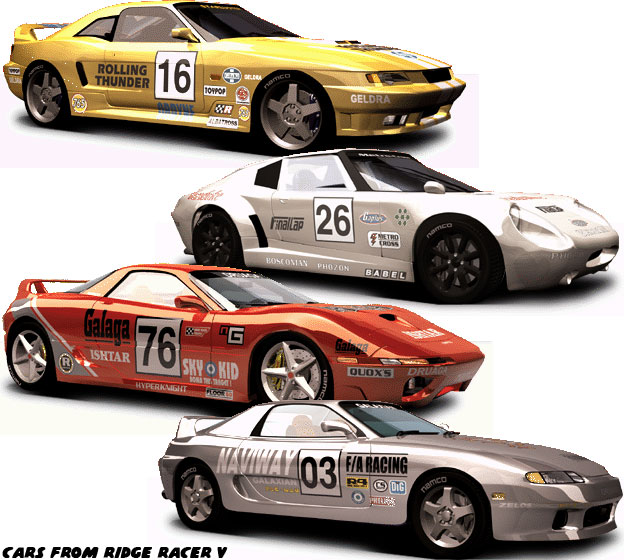
A small collection of cars was developed to take advantage of the higher polygon count and sharper textures that the PS2 provided. Well, it was a good number of cars that could be unlocked to be fair but nowhere near the massive number that R4 had set. The new models were amazing nonetheless and had much greater fidelity than even most arcade cars. The rides captured the spirit of four of the biggest auto manufacturing nations. Without putting an actual production car in the lineup the USA, Germany, Italy and Japan were well represented. France and South Korean manufacturers would be represented as well. Players could easily identify the influences behind each fictional manufacturer based on the familiar stance and lines of each car.
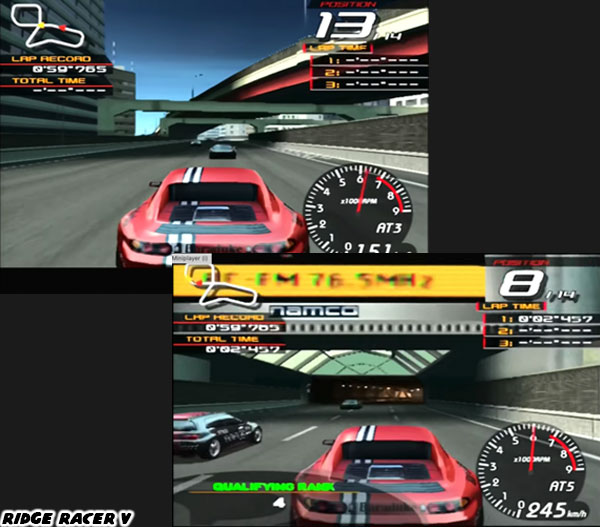
With Ridge Racer V Namco went back to the original idea that they had developed with Rage Racer. The studio had introduced a small number of courses in the game but in much greater detail than those found in any other title. The game had returned to Ridge City and it looked as if every inch of of the city was planned out and executed to exacting specifications. No arcade or console release could match the vividness of the new Ridge City. To help give racers a sense of immersion this time the music in the game was piped in through the fictional radio station Ridge FM. Its host would act as as narrator to the events as well as DJ to the mix of electronic and alt rock acts that were featured on the soundtrack.
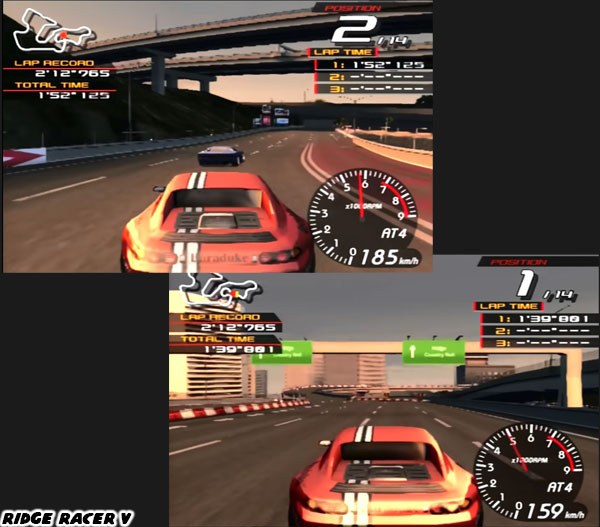
Players began to notice familiar neighborhoods and landmarks from previous visits to Ridge City. It was the first time that portions of downtown were not under construction. New skyscrapers dotted the scenery and new freeway exchanges had been introduced to the circuits. This Ridge Racer Project took careful note of every block and officially began labeling every part of the city. From the futuristic Downtown and high rises of Trading Square to the manicured lawns of City Park and even the natural beauty of Mount Valley. For the first time in almost a decade it really did appear as if Ridge City were based on a real world location. There was still plenty of room to grow and explore as the programmers at Namco began to add information onto the courses for future builds of the game. There were roads that were designed to compliment the new courses. They wove through the city and well off into the countryside as well. Those roads could be seen from the Bayside Line and Above the City courses but were not playable. The map data would remain however for future use.
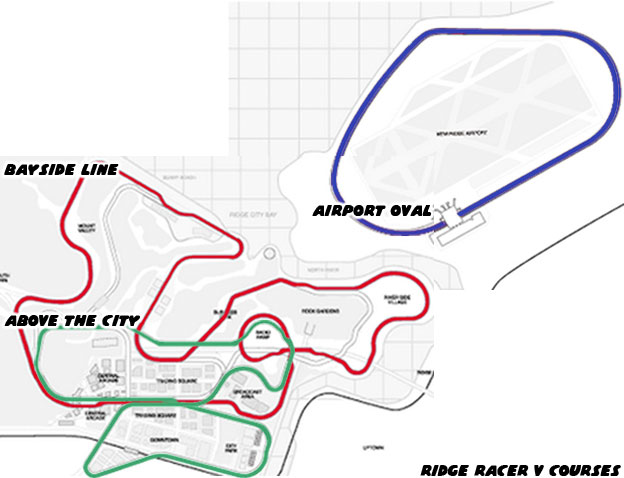
The team had marked out locations to touch upon in further sequels but what they did with the existing real estate was genius. Through 1999 and 2000 Namco had split their talent between Ridge Racer 64 and Ridge Racer V. Digipen helped develop the Nintendo 64 hit and Sony made sure that the company had the tools that would help get the most out of the Playstation 2 dev kits. Even with the extra attention the team was spread a little thin. For the Playstation 2 the team knew that they had to wow their fans with a solid version of Ridge City if they were not going to put them on random tracks around the world. So they laid out a foundation that they could spend the next few years building on. This foundation was done in the literal sense of the word. The side streets and connecting roads not used in the circuits could be opened up in a subsequent title. Not only that they actually designed some tracks that ran underneath existing architecture.
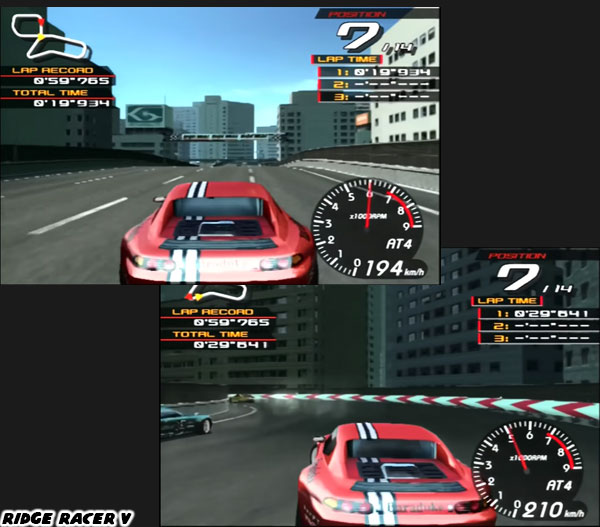
The Airport Oval for example added the staple airport track to canon. The track was actually designed in layers. The Airport Oval was built below ground level. It ran around the perimeter of the runway and adjacent to the airport proper. A series of tunnels prevented drivers from seeing much of the airport itself. The airport runway circuit that most fans would remember was "Aviator Lap." It took place above ground and just a few feet from parked jumbo jets. That track would be featured in Ridge Racer 6 and 7 for the Xbox 360 and Playstation3 respectively. Aviator Lap would take years to model and program so Airport Oval was what the team could introduce to expend the real estate for Ridge City. In Ridge Racer V the buildings and terrain that would make up Aviator Lap were missing assets. Sharp-eyed players could actually spot the columns and framework for future expansions in the distance. The Namco programmers had placed some unfinished models in the background as scenery. These free standing support structures and pylons would eventually become the bridges and freeway system that connected the airport to the rest of the city.
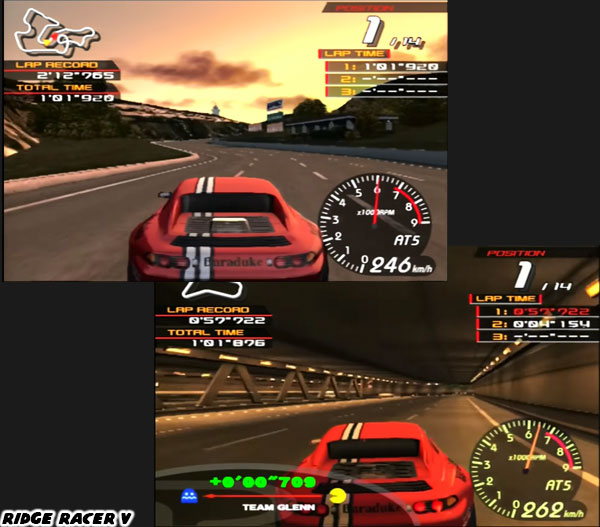
Namco would continue to pave over the roads and infrastructure that they had built in Ridge Racer V through the next decade. While it may not be considered a high-point for the series, at least not as revolutionary as R4, the game did a tremendous job at teaching the Ridge Racer Project members how changes in hardware, graphics and storage would have to be addressed going forward. As powerful as the Playstation 2 hardware was there was still a demand from the Japanese arcade scene for quality arcade racers outside of the home. In 1993 the original Ridge Racer ran on Namco's proprietary System 22 hardware. The 32-bit engine was very far ahead of its time and very expensive to manufacture. By 2000 they were touting the System 256 engine which was a dozen times more powerful and much less expensive. What many arcade visitors did not realize was that the System 256 was architecture designed for the Playstation 2. In this way the studio could "double dip" and have a game developed for the arcade in parallel with the console. Namco was not the only publisher to do this. Konami's Python hardware ran in much the same way.
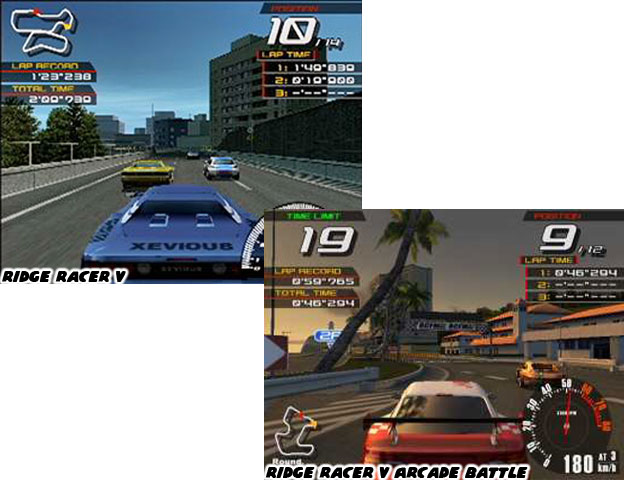
Namco released Ridge Racer V: Arcade Battle a year after the console. It had a minor bump in the graphics department and also allowed network gameplay and rankings. It had the main courses and a selection of the same cars as the home console but it lacked all of the other modes. It was a beautiful but bare bones racing experience that not many people in the USA ever got a chance to see. By 2001 the arcade scene had pretty much dried up in the US. Those same racing fans however did not miss the greatness of the "next-gen" racing experience.
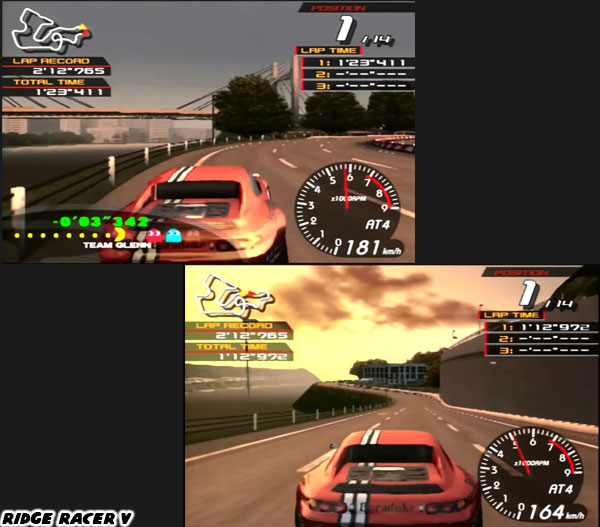
Players could not only customize their rides with colors but they could also swap out engines and add a layer of "tuning" that had been missing in previous versions of the game. The highlight was the hidden content of course. The most diligent of players were rewarded with a special Pac Man cameo. Instead of simply driving as Pac Man they actually were entered into the Pac Man GP. Players assumed the role of the titular mascot and raced against his four rival ghosts. The ghosts sported sunglasses and rode on top of scooters that were capable of putting almost every super car to shame. If players beat the required circuit times then they could unlock Pac Man and the ghosts.
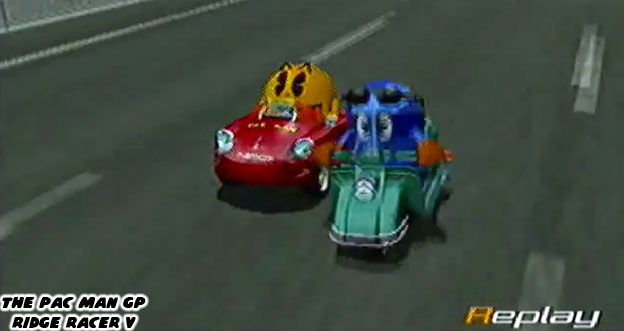
Ridge Racer V was a good game but it felt lacking. Perhaps it was that the team had pulled double duty developing this game and an N64 version during the same cycle. The previous game was as close to perfection as the series had ever reached. Audiences expected a little more immersion in the game and not simply better graphics.
As always if you would like to sponsor me
please visit my Patreon page and consider donating each month, even as little as $1 would help make better blogs and even podcasts!


















better graphics does work on some; just not all though.
ReplyDelete